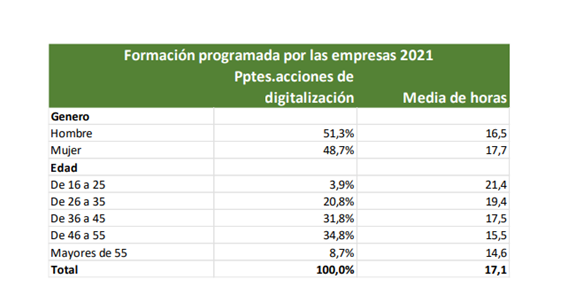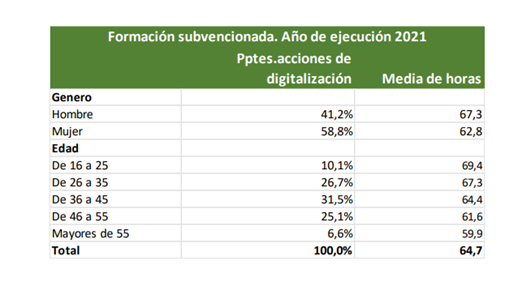28/09/2022
According to a study by the European Commission, 90% of jobs in Europe require or will soon require some form of digital skills. The same study also highlights that 40% of workers are concerned that they do not have the necessary skills.
The answer lies in training, at all stages of our lives. This training also has a strong focus on new technologies and soft skills that are often associated with digital tools and the social change triggered by this Revolution 4.0.
In this context, the Government of Spain plans to allocate more than 20 billion euros from the Recovery, Transformation and Resilience Plan to boost digital transformation, with a particular focus on training the people who will make this transformation possible.
A recent report by FUNDAE (State Foundation for Employment Training) analyzes the profile of people who, in 2021, took subsidized or in-company training on digital skills:
Training programmed by companies 2021
During 2021, in the training programmed by the companies (or planned training), actions related to digitalization accounted for 10.6% of participants; a total of 8.8 million hours in digital skills training, equivalent to an average of 17.1 hours per student, four hours more than the overall average (13.4). It should be noted that training courses are somewhat longer among the youngest (21.4 hours on average) and shorter among the oldest (14.6 hours).
Most of the students were trained in the classroom mode (56%) and received the shortest training, averaging 11.5 hours. 43.1% have been trained through e-learning with an average duration of 24.3 hours; blended learning, which combines classroom and online training, accounts for only 0.5% of participants and is the longest training modality: 35.8 hours on average.

As for the profile of the average student in digital competencies, we hardly observed any differences by gender, although we did observe differences by age and educational level. Two out of every three participants are over 36 years of age (66.6%), while the youngest (16 to 25 years of age) represent only 3.9%.
Also, almost six out of ten participants who in 2021 undertook training related to digitization actions have higher education (58,9%), more than twenty points difference The proportion of those with a primary education is 11.1%, eighteen points lower than in the initiative as a whole.
In professional categories, managers, middle managers and especially technicians show more interest than skilled and low-skilled workers. The Community of Madrid, followed at a significant distance by Catalonia and Andalusia, leads the ranking of those trained in digitalization actions.
Subsidized training in 2021
The figures follow a similar pattern when it comes to subsidized training (or supply-side training). There are more women than men (58.8% to 41.2%) and the average age of the participants is slightly lower. People over 36 years of age represent more than half of the users and, as in the case of training programmed by companies, older people are the ones who take the shortest training courses.

The courses in subsidized training are somewhat longer, although they are below those given in other areas not related to digitization. People with higher education (47.4%) are also more present here and, once again, managers, middle management and technicians are the most interested. “This data is worrying, because the training on offer is called to provide the basic training that encourages students to continue training and specializing,” says Javier Miranda, head of Talent and Employment at DigitalES. “The great challenge of training for employment is to reach all layers of society, including people of all academic levels and all types of previous skills,” insists Miranda.
“The great challenge of training for employment is to reach all layers of society, including people of all academic levels and all types of prior competencies.”
In contrast to training provided by companies, e-learning (48.5%) attracts more students than face-to-face training (41.9%). The autonomous communities with the highest number of participants trained in this type of actions are Andalusia (23%), Madrid (20.3%) and Catalonia (8.9%).
Valuation of DigitalES
“Spain should set itself the objective of continuing to increase the average number of hours of some training courses, particularly in the area of planned or subsidized training. It is also important that the ‘culture’ of continuous training permeates all strata of society, so that social inequalities are not aggravated as a result of the different degree of professional specialization achieved,” says the DigitalES expert.
As a sign of optimism, Miranda notes a constant evolution of in-company training towards formulas that have proven to be very effective, such as training itineraries and specialized micro-training.










